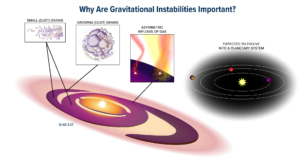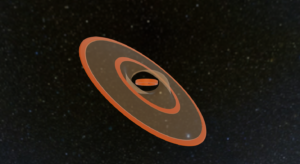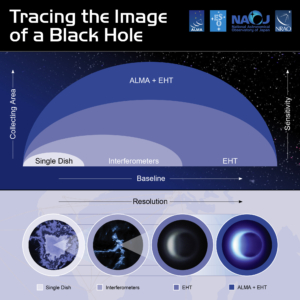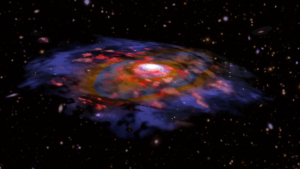Elias 2-27 is a young star located just 378 light-years from Earth. The star is host to a massive protoplanetary disk of gas and dust, one of the key elements to planet formation. In this graphic illustration, dust is distributed along a spiral-shaped morphology first discovered in Elias 2-27 in 2016. The larger dust grains are found along the spiral arms while the smaller dust grains are distributed all around the protoplanetary disk. Asymmetric inflows of gas were also detected during the study, indicating that there may still be material infalling into the disk. Scientists believe that Elias 2-27 may eventually evolve into a planetary system, with gravitational instabilities causing the formation of giant planets. Because this process takes millions of years to occur, scientists can only observe the beginning stages.


3D Model of the GW Orionis Triple System
Augmented Reality representation of the disc structure and stellar orbit of the GW Orionis triple system, as derived from the ALMA and VLT observations by Kraus et al. Orange rings are the (misaligned) rings seen by ALMA. The transparent surfaces correspond to the lower-density dust filaments that connect the rings and that dominate the emission in scattered light. Project the system in the real world with newer smart phones and tablets or use your desktop mouse to interact with the model. To obtain the view from Earth, view the model from top.

Tracing the Image of a Black Hole – EHT and ALMA
This infographic illustrates how ALMA contributes to the EHT observations. With its shorter baseline, ALMA is sensitive to larger scales than the EHT and so ALMA can fill in the lower-resolution, larger-scale structures that the EHT misses.

The Event Horizon Telescope – A Global Network of Radio Telescopes
Diagram of the EHT Network used for the observations in 2017.

Artist’s animation of a dusty, rotating distant galaxy
Artist’s animation of a galaxy in the early universe that is very dusty and shows the first signs of a rotationally supported disk. In this image, the red color represents gas, and blue/brown represents dust as seen in radio waves with ALMA. Many other galaxies are visible in the background, based on optical data from VLT and Subaru.

Artist’s illustration of a dusty, rotating distant galaxy
Artist’s illustration of a galaxy in the early universe that is very dusty and shows the first signs of a rotationally supported disk. In this image, the red color represents gas, and blue/brown represents dust as seen in radio waves with ALMA. Many other galaxies are visible in the background, based on optical data from VLT and Subaru.





